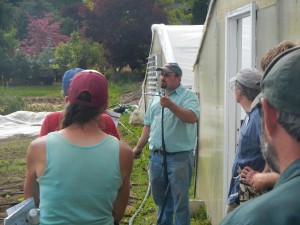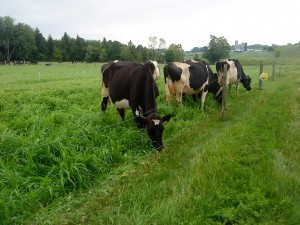Despite a very dry May, this June was one the wettest on record for many areas in central and northern Vermont. So wet, in fact, that registrations for an on-farm UVM Extension irrigation workshop scheduled for July 16 were scant, leading us to cancel the workshop. (Even so, many thanks to River Berry Farm in Fairfax for agreeing to host; we do plan to re-schedule for next summer!)
Prior to our decision to cancel, I had a discussion with one of our invited experts, Trevor Hardy, on the sanity of scheduling an irrigation workshop given all the rain (granted, it seemed like a great idea back in May!). Trevor made the excellent point that farmers with fertigation capabilities, or irrigation systems that can deliver crop nutrients, will be in an enviable position this year. They will be able to maintain/replace fertility, without having to traffic sensitive, wet soil. Undoubtedly, the excess rainfall has leached significant nutrients (especially nitrogen) out of the rootzone, or saturated soils have led to conditions ripe for denitrification loss of any remaining nitrogen. Fertigation equipment can be added onto new or existing irrigation systems, organic or conventional, and can also save on labor and energy required for conventional nutrient applications.
Even though this summer’s weather has been seemingly ‘abnormal,’ we know unpredictable seasons like this are likely to become more ‘normal’ in the future with climate change. The rapid shift from very dry spells to very wet spells and vice versa is expected to become more common, as well as droughty periods interspersed with intense storms where most rainfall runs off. These are the conditions that likely make irrigation a wise investment moving forward, especially water-efficient systems such as drip irrigation (which may also be smart given new produce safety rules).
As you think about irrigation and water management on your farm, please be in touch if we can provide technical assistance (contact information below). I know that Trevor Hardy in Hollis, NH (Brookdale Fruit Farm*) is an experienced irrigation system designer and equipment supplier, and is glad work with Vermont farmers.
For further reading, here is a link to a publication from University of Florida Extension that is one of the best mini-guides to drip irrigation that I am aware of. Also, please let us know if you have favorite irrigation resources and contractors that you’d like share.
Joshua Faulkner
UVM Extension Center for Sustainable Agriculture
Joshua.faulkner@uvm.edu
802-656-3495
*Any reference to commercial products, trade names, or brand names is for information only, and no endorsement or approval is intended.


Recent Comments